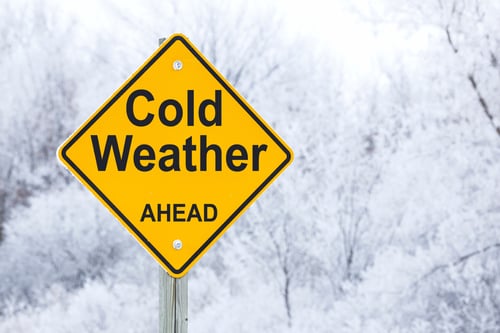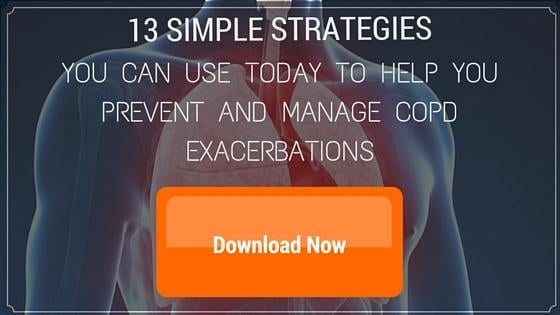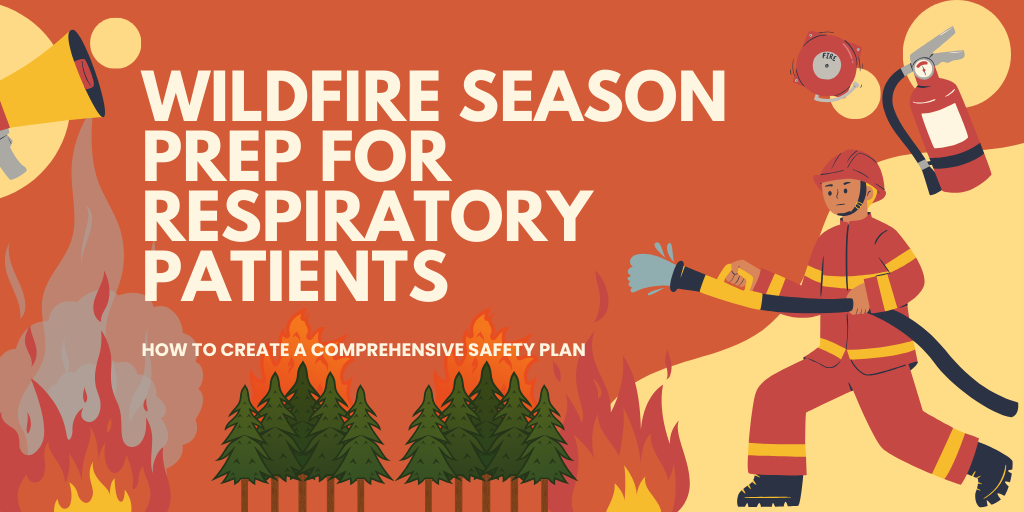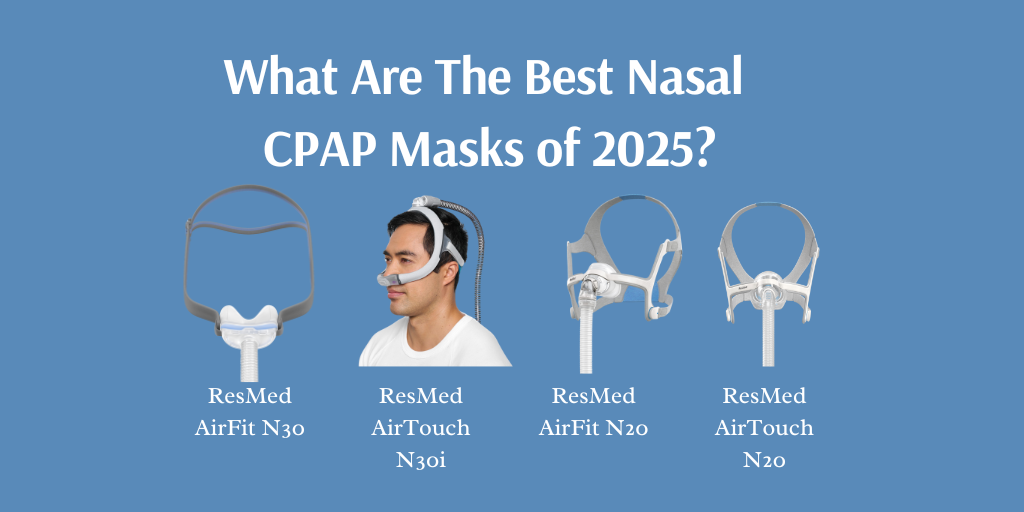How Does Cold Weather Affect Your COPD?

Weather extremes can have a significant impact on your COPD. During winter the majority of the US is subjected to freezing temperatures and strong winds. Freezing temperatures can make it increasingly difficult to breathe, cause fatigue, and in turn leave you housebound for most of the winter. In fact, cold weather and strong winds are known to be COPD exacerbation triggers.
Going outside when the temperature is below freezing with COPD is much like jumping into a pool of cold water, it takes your breath away. The only difference is, with COPD it’s infinitely harder to catch your breath and regroup. Cold air shocks your airway and causes it to tighten up. This prevents air from getting to your lungs and causes you to feel short of breath.
On top of the cold weather shocking your airway, it’s also known to cause an increase in phlegm/sputum production. As your body produces more phlegm/sputum it can become even more difficult to breathe and expel the phlegm. This is one symptom you will want to pay close attention to. If your phlegm production increases and changes color it may indicate you are experiencing an exacerbation.
Cold weather is often times accompanied by strong winds. Although everyone reacts differently, strong winds can negatively affect your COPD. Exposing yourself to strong winds can leave you feeling short of breath without warning, have you feeling fatigued in a short period of time, and it can even lead to a COPD exacerbation. The feeling of breathlessness and fatigue can be attributed to wind resistance making it harder for you to move. In some cases it doesn’t even have to be a strong wind to take your breath away. There have berous reports on COPD patients having difficulty breathing when a fan is pointed at them.een num
In fact, you are at a higher risk of experiencing an exacerbation during the winter months. There are numerous risk factors that are heightened during the winter months. Aside from cold weather and strong winds, air pollution is increased in the winter, which can cause you to have breathing problems. Cold and flu season is also at its peak during winter. You don’t need us to tell you how hard it is to deal with a cold or the flu when you’re already battling COPD. More times than not, catching the cold or the flu will lead to an exacerbation or worse.
While it’s best if you avoid going out in extreme temperatures and strong winds, we know that it’s impossible to avoid them all of the time. We will go over some tips and best practices to help you beat winter a little later in this post.
Peak Cold and Flu Season
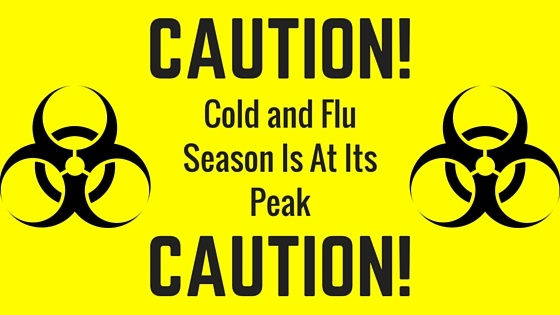
One of your top priorities with COPD should be to stay healthy and avoid getting sick. During the winter months, when cold and flu season is at its peak, it’s important that you are extra vigilant on your quest to stay healthy. If possible, do your best to avoid large crowds and make sure all of your friends and family know not to come over when they are feeling under the weather. With COPD you are at a higher risk of getting sick, not to mention, falling ill with the cold or the flu can be detrimental to your COPD.
Both the common cold and the flu are known to cause COPD exacerbations and they make it exponentially harder to manage your symptoms. This is partly due to the fact that cold and flu symptoms; coughing, increased phlegm production, shortness of breath, etc., overlap with COPD symptoms. With the illnesses having overlapping symptoms it’s easy to see how catching the cold or the flu can lead to an exacerbation.
Exacerbations aren’t the only thing you need to worry about if you come down with the cold or the flu. Because your body is already dealing with COPD, a cold or the flu can easily turn into pneumonia. Catching pneumonia with COPD is especially dangerous and potentially life-threatening. Both COPD and pneumonia are risk factors for respiratory failure so when you combine both of them the seriousness is heightened.
Unfortunately there is no vaccine for the common cold, but the best way to protect yourself from falling ill with the flu is to get vaccinated. Another key vaccine to speak with your doctor about is the pneumonia vaccine. By staying on top of your vaccinations you will drastically reduce your chances of getting sick with one of those two illnesses.
How to Manage Your COPD in Winter
After reading all of that information, it’s understandable if you are nervous for winter to come, but don’t worry because we have tips, hints, and strategies to help you manage your COPD and beat winter for years to come.
Breathing Tips
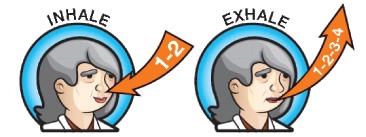
Breathing in freezing cold air shocks your airways, causes you to lose your breath, and makes it increasingly difficult to catch your breath. There are a few different ways you can prevent this from happening:
Proper Breathing Technique- You probably know this from your pulmonary doctor or pulmonary rehab program, but the correct way to breathe starts by inhaling through your nose and exhaling through your mouth. This is especially true during the winter. Inhaling through your nose gives the cold air a chance to warm up and gain a little humidity before it makes it to your lungs to prevent the shocking effect.
While you are out in the cold, the pursed lip breathing technique will help you control your breathing rate, reduce the feeling of breathlessness, and help you get used to inhaling through your nose.
Breathing in the Extreme Cold- Sometimes, when the weather is unbearably cold, simply inhaling through your nose doesn’t make the air warm enough to prevent the shocking effect on your airway. Now when it’s this cold out, it’s best to stay inside. However, if you must go outside cover your nose and mouth with a scarf to give the air more time to warm up before it gets to your lungs.
Once again, using the pursed lip breathing technique will be extremely helpful when you are out in the cold.
Handling the Extreme Weather
In an ideal world, all COPD patients would be able to move to a warmer climate for the winter. Unfortunately that is impossible to make happen. So what do you do if you can’t spend the winter in a state like Florida or Arizona?
Check Weather and Air Quality Reports
Staying on top of weather and air quality reports will put you ahead of the game. You will know what to prepare for and what to expect. The key measurements you want to watch for are temperature, wind chill, humidity, and pollution levels.
Temperature
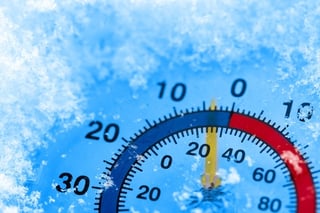 The cold temperatures really start to affect COPD symptoms when they are 32 degrees Fahrenheit or lower. By monitoring the temperature you will be able to plan your week accordingly.
The cold temperatures really start to affect COPD symptoms when they are 32 degrees Fahrenheit or lower. By monitoring the temperature you will be able to plan your week accordingly.
For example, if you notice there is a day in the week that will be a bit warmer, that would be the perfect day to get out of your house and run some errands. If you notice there is going to be a cold front with snow later in the week, you will know to run your errands and take care of a few things around your house before the snow comes.
We know it’s impossible to avoid going outside in the winter when the temperature is below 32 degrees so here are some simple tips that will help you beat the cold when you have to go outside:
- Wear loose fitting clothes so you don’t restrict the flow of oxygen
- Wear a scarf or face mask to cover your nose and mouth to give air a chance to warm up before it hits your airway and it will help prevent the wind from making it hard to breathe (These fleece face masks are perfect for winter)
- Breathe in through your nose and out through your mouth to prevent cold air from shocking your airway
- Keep your oxygen tubing inside your shirt or jacket to keep your oxygen as warm as possible
- Walk with the wind, not against it. This will preserve your energy and help keep you from feeling fatigued
For temperature, wind chill, and humidity measurements in your area visit www.weather.com and input your zip code for the most accurate data.
Air Quality

Monitoring the air quality in your area can make a big impact on your ability to breathe. In the winter months air pollution is increased from people running their fireplaces and wood stoves, not to mention people leaving their cars running to warm them up. All of these actions lead to higher levels of particulate matter and carbon monoxide in the air. Unfortunately, the cold weather and stagnant air have the ability to create a build-up of these substances near the ground.
As you check the air quality reports in your area you want to make sure you aren’t exposing yourself to high levels of pollution. COPD makes your body extremely sensitive to lung irritants and pollution levels that are considered high for people without a lung disease are very dangerous to expose yourself to.
This is why you need to monitor the air quality reports for your area. Here is the list of air quality ratings and what they mean for you:
Good- Good air quality shows up on the map in green. When the air quality is good it means pollution poses little or no risk to you.
Moderate- Moderate air quality shows up on the map in yellow. When the air quality is rated as moderate it means the air quality is acceptable, however, some pollutants may be a moderate health concerns for people who are sensitive to pollution. This includes lung disease patients. Because COPD affects everyone differently, you will want to pay attention to how you feel when you go outside with moderate air quality. If you notice you have trouble breathing try to limit your time outdoors.
Unhealthy for Sensitive Groups- When the air quality is unhealthy for sensitive groups (USG) it shows up on the map in orange. If the air quality is rated USG you should try your best to not go outside. If you absolutely must go outside, limit your time outdoors and monitor your symptoms to make sure they aren’t flaring up. USG air quality means you are at a greater risk of having issues with your COPD from ozone exposure and from particulate matter in the air.
Unhealthy- Unhealthy air quality shows up on the map in red. When the air quality is rated as unhealthy it means that everyone healthy or not can experience negative health effects from being outdoors in the polluted air. With COPD, or any lung disease for that matter, you need to make sure you don’t go outside unless it is 100% necessary.
Very Unhealthy- Very unhealthy air quality shows up on the map in purple. Everyone is at risk of experiencing serious health effects. If the air quality ever gets this bad in your area DO NOT go outside for any reason.
Hazardous- Hazardous air quality shows up on the map in burgundy. This is considered emergency conditions and everyone in the population is more likely to be affected by the air quality. Again, if the air quality ever gets this bad in your area DO NOT go outside for any reason.
If the air quality is rated USG or worse, do everything within your power to avoid going outside. As you may already know, environmental pollution is one of the leading risk factors for COPD. Exposing yourself to these levels of pollution can lead to a COPD exacerbation and will definitely make your COPD symptoms worsen.
To get the air quality report (pollution report) visit www.airnow.gov/ and input your zip code for an up-to-date air quality report.
Remaining Active During Winter
One of the most effective ways to treat and manage your COPD is by exercising regularly and living an active life. When the cold weather comes it’s easy to let your activity levels drop and reduce the amount you exercise. For one, not very many people enjoy being outside in the cold and secondly, the cold weather can negatively impact your COPD. However, you should do your best to stay on your regular exercise schedule and be as active around your house as possible. Use these actionable tips to stay active during the winter and proactively manage your COPD.
Exercising During Winter
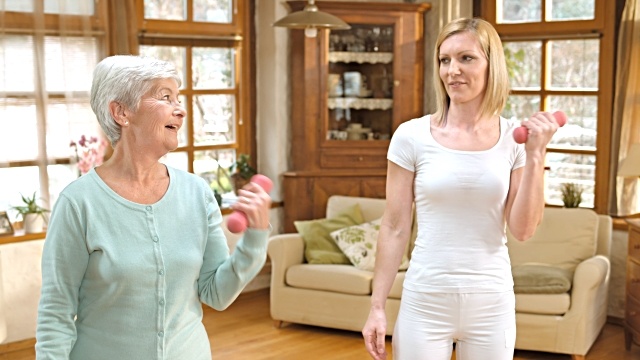
Exercising during the winter with COPD can be a difficult process. One of the most effective workouts for COPD is walking, but the cold weather makes it increasingly difficult to go outside get your exercise. While you can always hop in your car and go to the gym to walk on a treadmill and do other exercises, maybe you don’t like the gym. Then what? What if it’s a blizzard and you can’t make it to the gym? Exercise in the comfort of your own home!
It may not be the most glamorous place to exercise, but what does that matter? As long as you are getting your workout in and remaining active, you are proactively treating and managing your COPD. Here are some examples of how you can exercise in the comfort of your own home:
Walking
Using a pedometer or your smartphone’s health app you can walk around your house to get your exercise in. Whether you want to walk up and down the stairs, wander aimlessly around your house, or just walk around your main floor you will be able to get a good walk in every day. It doesn’t sound like a lot of fun but there are plenty of ways to make it interesting.
You can play your favorite music and jam out around your house. You can turn it into a training game with your dog by having them follow you and giving them commands to follow like sit, stay, roll over, etc.. You can play hide and go seek with your grandchildren. Really the possibilities are endless.
You want to use a pedometer or the health app on your smartphone to track your number of steps and how far you walked.
Strength Exercises
Strength exercise is an extremely important aspect of treating and managing your COPD. Inactivity leads to deconditioning and can make it harder for you to breathe when you are active. You don’t need to head to the gym or step outside in the winter weather to get a good strength workout in. These exercises are easy to conduct in the comfort of your own home:
Upper Body Exercises
Strengthening your upper body will help reduce the feeling of breathlessness and it will give you more energy throughout the day. Here is a list of upper body exercises from Eldergym.com and SitandBeFit.com you can do in your own home:
- Bicep Curls
- Side Shoulder Raises
- Upright Rows
- Overhead Elbow Extensions
- Overhead Press
- Elbow Side Extensions
- Here is a link to the Sit and Be Fit YouTube Page: https://www.youtube.com/user/SitandBeFitTVSHOW
Lower Body Exercises
Strengthening your lower body will also help prevent deconditioning and it will help improve your mobility. These exercises from Eldergym.com and SitandBeFit.com will help you strengthen your lower body in the comfort of your own home:
- Squats
- Lunges
- Ankle Circles
- Hip Marching
- Knee Extension
- Calf Raises
- Sit to Stand
- Heel Stand
- Straight Leg Raise
- Hip Extension
- Here is a link to the leg strengthening videos on the Sit and Be Fit YouTube Page: https://www.youtube.com/playlist?list=PLiBGdcawVC9yVjwnQZgdS636DG_iQYGFD
Stretching Exercises

Stretching exercises are simple and easy to do in the comfort of your own home and they are extremely beneficial. Stretching is a proven method to prevent injuries, soreness, and stiffness during and after each workout. Even if you aren’t working out that day stretching can improve the way your body feels each day. It can reduce muscle fatigue, reduce the feeling of soreness, and help prevent future injuries.
Here is an extensive list of upper body and lower body stretched from Eldergym.com:
Upper Body Stretches
- Shoulder and Upper Back Stretch
- Shoulder Rolls
- Neck Side Stretch
- Neck Rotation
- Shoulder Circles
- Shoulder Stretch
- Chest Stretch
- Overhead Reach
- Reach Back
- Triceps Stretch
- Hand Stretch
- Arm Raises
Lower Body Stretches
- Seated Lifts
- Standing Quadriceps Stretch
- Back Stretch
- Inner Thigh Stretch
- Calf Stretch
- Hip Side Stretch
- Hip Rotation Stretch
- Soleus Stretch
- Ankle Circles
- Hamstring Stretch
- Knee to Chest
- Ankle Stretch
As always, before you start exercising on your own, be sure to talk with your doctor about how much exercise you can handle. There’s no reason to over-exert yourself and do more harm than good.
Conclusion
Successfully managing your COPD in the winter is no easy task as you can see by the amount of information above. Take it one step at a time and put these actionable tips to work. Check the weather and air quality reports. Avoid large crowds of people and people who are sick. Stay active and make sure you keep exercising. Be extra cautious when going outside in cold weather with strong winds.
What are some ways you beat the cold that we didn’t mention? Comment below and let fellow COPD patients in on what works for you. If you found this article helpful, share it with friends and family through social media or email it to them.
In the mean time, click the image below to download our free e-book, 13 Simple Strategies You Can Use Today To Help You Prevent And Manage COPD Exacerbations!


